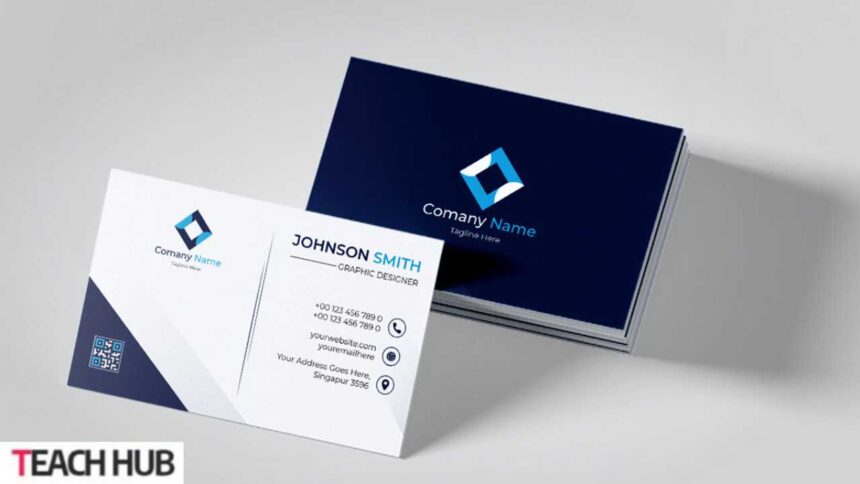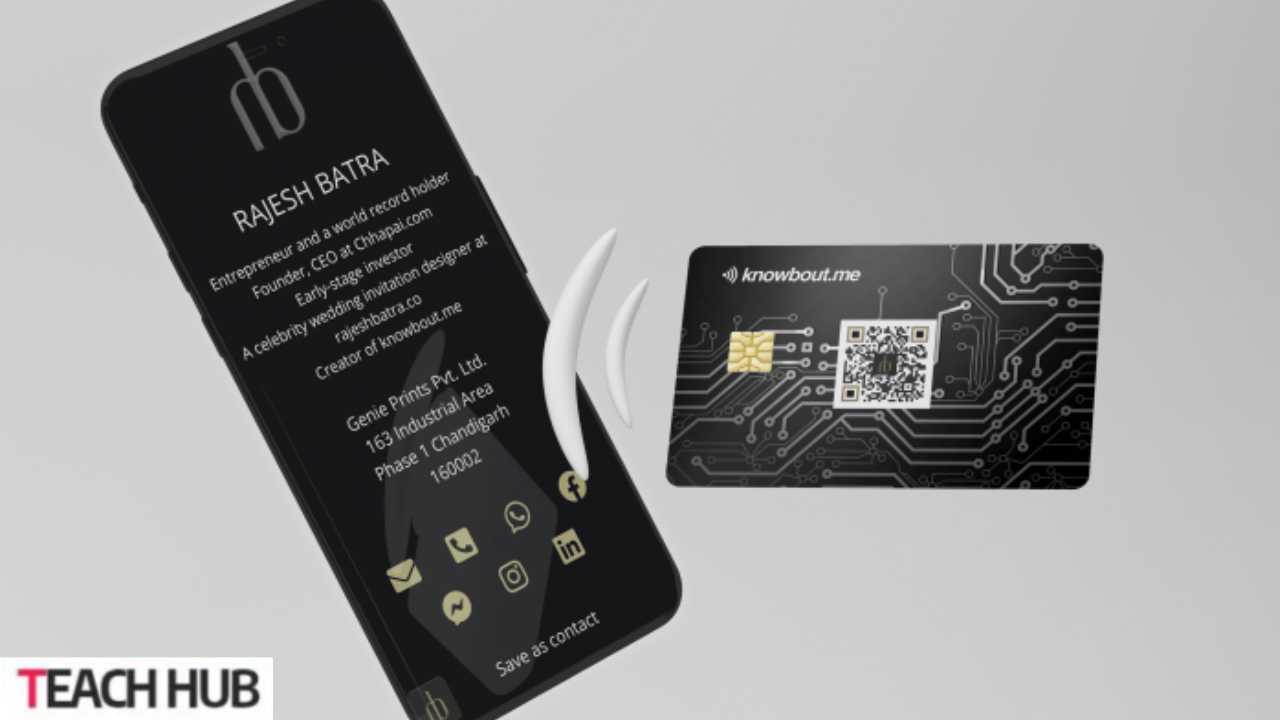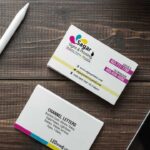Being a professional today can be challenging in this fast-paced digital world. A handshake is often an essential indicator of professionalism in the business world, and although communication happens digitally, a business card remains that much-needed starter for a great memory.
Luckily, designing a business card has never been so effortless. Contemporary design tools and creative ideas can help you create a card that projects the necessary information and your identity. Make a difference by acting: an outstanding way to do this is by adding unique NFC technology and eco-friendly materials to the card.
The business card design is the ticket to revamping your attitude toward networking. The article below offers tips, techniques, and trends to help you uplift your professional presence.
Meaning of Design Business Cards
A Business card is the physical representation of your brand and contact information. It should represent the core values and aesthetics of the business being made memorable and functional. Start by finding a delicate balance between creativity and clarity.
If your business cards are unique, they will be more special for your possible customers and set you apart from your competitors. Add other fascinating textures or finishes such as embossing, foil stamping, or dull layers to the cards so they appear in the hands of the individual who accepts them.
How to Design Your Business Cards?
Creating your business cards can be very fun. First, choose a design tool or platform you may need: Adobe Illustrator, Canva, or something else. Browse through several templates to find the one that should suit your brand. Apply the necessary elements of your brand – a logo, colors, and typography.
Remember to add contact information to your card. Test various designs to discover which best describes your brand. Remember that it can be mighty; make sure to make an impactful and lasting one.
Free Downloads for Business Card Design Templates
You could seek free card design templates on a budget. Canva and Adobe Spark have loads of free templates that you can then use to give your business a unique style and needs. These design elements offer interactive elements where you can edit a template, changing its colors, fonts, and images.
Using these options for your business cards design can save you time and money while retaining the professional look that comes with your brand’s image.
NFC Technology in Business Card Design
Another new trend in business cards is the implementation of NFC technology. This is a very innovative twist on a traditional business card, as it can hold digital information that can be transferred to a smartphone with a tap. This technology enables people to quickly share contact information, websites, and social media profiles in networking, thus developing networking efficiency.
NFC business cards would prove very helpful for tech-savvy professionals who seek to emphasize the integration of innovation and forward-thinking in business.
Design Free NFC Business Cards
NFC business cards are created by embedding a tiny chip on a card that sends data from the small chip. With this, you can share your contact information, social media profiles, and many more in a snap. There are several free online services through which you can create and code your NFC business card.
The service generally comprises templates and other elements for creating and personalizing the physical appearance of the card, with guidance on embedding the digital information. Using these materials, you can make an NFC business card that captures the essence of traditional design while imitating the latest technological facets.
Unique Trends
Stay up-to-date with the prevailing design trends to ensure your business card becomes the most sought-after business card. The latest favors clean lines with vast white space, expressing sophistication and clarity. Sustainable materials are another upsurge, showing a sense of emerging environmental responsibility.
AR features are also integrated into business cards, creating an interactive experience with the recipient. The business card will leave a mind-blowing impact on the recipient’s face. Try the above trends and create a design that puts your brand’s ethos forward.
The Art of Personal Student Business Cards Designs
A personal business card can be an outstanding resource for someone entering the professional world. These should include personal achievements in academics and areas where they have unique talents and expertise, along with their contact information.
Imagine bold and energetic designs that reflect youth and a dynamic personality. Customizing your card with school colors or logos like Virginia Tech’s might help.
Funeral Home Business Card Design
Designing business cards for a funeral home is sensitive and professional. The style evolved would reflect respect, empathy, and trust. All this would be done with muted colors and timeless fonts that convey a feeling of the seriousness involved in the service.
All contact information should be visible to ensure all website postings are optional soothing or comforting messages. Whether embossed or high-quality finishes, the card will convey a class level and ensure it does not leave a poor impression.
Virginia Tech Business Card Design Strategies
A Virginia Tech business card design should depict the school’s spirit and values. To achieve consistency in branding, try to include the school’s color schemes and available logos. To give more context, include affiliations, like departments or clubs.
The look must be professional yet approachable, appealing to academic and business communities. High-quality materials and printing techniques must ensure that these cards reflect the excellence the institution seeks.
The Creative Functionality
A sound card design should be both creative and usable. Innovative, eye-catching designs can win customers’ attention, but the card must also convey its contact information and brand identity.
Consider whether unique shapes, textures, or interactive elements can add even more appeal without disrupting the card’s readability or usability. Prototyping will bring you the desired harmony between form and function for your needs.
Harnessing Online Tools to Design Your Business Card
Online tools enable individuals to provide free and flexible choices for designing business cards. Some of the leading platforms include Canva, Vistaprint, and Moo.
They provide an amicable interface that allows a person to use and mix templates with customization options. The online resources allow businesses of all sizes to create professional designs without much knowledge of graphic design. Try out different platforms to discover what suits your preferences and budget.
Business Cards Design Through the Years
Business cards have evolved from simple black-and-white prints to complex and multi-functional designs. Many of today’s cards include digital elements like QR codes and NFC chips, deep into the contemporary infusion of technology into professional networking.
Changes in trends, materials, and printing technologies across history have made business cards even more conspicuous; understanding such an evolution inspires concepts associated with the evolved audience.
Printing and Distributing Business Cards Strategy
Effective printing and distribution will maximize the effect of your business cards. Choose good-quality printing services that will sharpen images and colors for vibrant printouts while using long-lasting materials.
Decide on distribution methods that fit the networking objective, such as releasing during the event or attaching it in correspondence. Digital sharing options, such as electronic NFC cards, can also complement the traditional business card distribution method, widening access.
Future Trends
If it has already occurred, it is clear that it will happen again: business cards will exhibit more technology and sustainability. Virtual and digital business cards are expected to be seen widely, and their legitimacy in paper-based cards will be pretty environmentally friendly.
The richness of augmented reality and personalized video content may soon arrive as interactive features at various levels. To stay on track, you can stay updated and innovative when designing business cards.
Conclusion
Business cards design remains an integral part of the personal and professional branding process. To guide you in developing business cards that effectively communicate your brand identity while cutting through the noise of a crowded marketplace, you learn the basics, adopt new technologies, and follow design trends.
Whether you are a student, professional, or business owner, being creative and having fun with card design may be the value you seek when branding.
Also, Read More: List of All Kinds of Business Cards
(FAQs)
What are the key considerations to consider when designing a business card?
Layout, typography, color strategy, and branding are some things to consider when making a business card. Your design must harmonize with your brand identity and encapsulate all the details people should contact you through. If you believe your card will appear professional only when printed on premium materials and with state-of-the-art printing technology, go ahead.
How do I make my business cards design creative?
As a final touch, you can spice up your business card using innovative design elements: shapes, textures, or finishes like embossing or foil stamping. You can embed technology such as NFC chips or QR codes into it to provide an interactive element, thus engaging the recipient with a contemporary touch.
Do you have any insight on a popular trend in card design that I should be looking for?
Yes, minimalist designs with clean lines and sustainable materials exemplify contemporary trends and exhibit an environmental consciousness. Besides, the card can also include a digital functionality in AR. The benefit of being in tune with this trend is that your card remains fresh and attractive.
Am I allowed to design free business card design templates
Many more web-based tools and platforms, such as Canva or Vistaprint, offer easy-to-use templates with many customization options to make professional-looking card design possible without graphic design skills. Of course, it is easier for everyone to make their unique card.
What should I include on my business card?
Your business card must include your title, job designation, business name, contact details, telephone number, e-mail address, and business symbol. Depending on your industry, you may also include the company’s social media handles or a website URL. The point is that everything has to be clear and easily readable at a glance.





